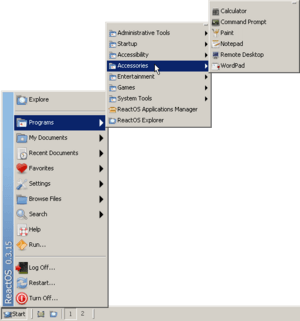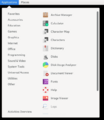Start menu facts for kids
The Start menu is a helpful part of a computer's screen that lets you control things. It's like a main control panel. You'll find it in many computer systems, especially Microsoft Windows. It helps you open programs, find files, change how your computer works, and even get help.
Since Windows 95, you can usually find the "Start button" at the bottom left of your screen. It's on the taskbar, which is the long bar at the bottom. When you click this button, a menu pops up. This menu lets you do many things, like:
- Find and open your programs.
- Look for files or documents.
- Change important settings for your computer.
- Get help if you're stuck.
- Turn off or restart your computer.
Contents
How the Start Menu Changed Over Time
The Start menu has changed a bit through different versions of Windows.
Windows 95 and XP
For a long time, the Start menu stayed pretty much the same. It was a simple list that popped up. In Windows XP, it got a slightly new look. It was still a list, but it had two columns to show more options.
Windows 8 and 8.1
With Windows 8 and Windows 8.1, Microsoft made a big change. They replaced the Start menu with a "Start screen." This screen took up your whole computer display. Instead of a list, programs and files showed up as large "tiles." These tiles could even show live information, like new messages or weather updates. Many people didn't like this big change because they were used to the old menu.
Windows 10
Because many users missed the old Start menu, Microsoft brought it back in Windows 10. This new Start menu combines the best of both worlds. It has the classic list of programs on one side. On the other side, it keeps the "live tiles" from Windows 8. This way, you get the familiar menu with the cool, interactive tiles.
Images for kids
-
The Windows 95 Start menu.
-
The Windows 7 Start menu.
-
The Start screen in Windows 8.
-
The Start menu in Windows 10.
-
Menu in GNOME Classic
See also
 In Spanish: Menú Inicio para niños
In Spanish: Menú Inicio para niños







